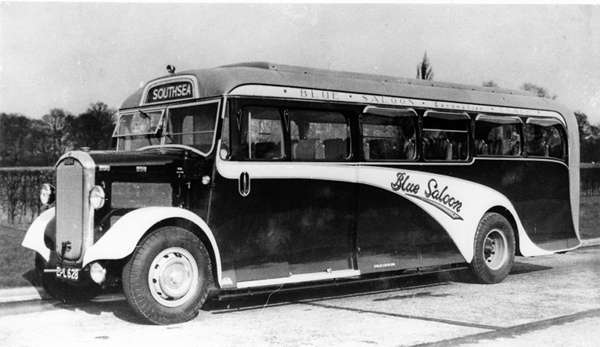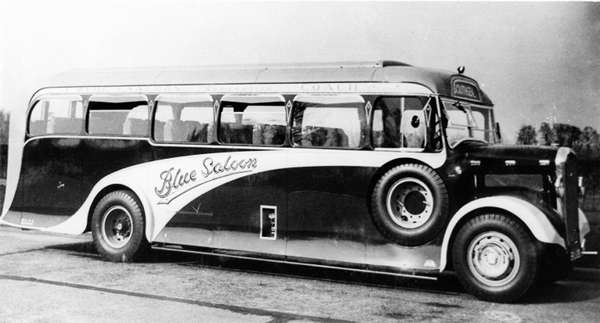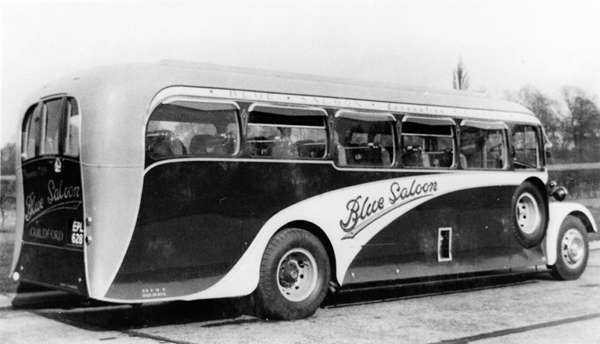Simpsons EPL 628

This is a Ron Doig image copyright Glasgow Vintage Vehicle Trust. Does anyone know anything about the vehicle?
Stephen Allcroft
28/10/15 - 13:30
Zooming in on the top of the rad there appears to be a rectangular makers name plate, though it gets too pixelated to read.
Could it be Dennis?
Anon
28/10/15 - 13:30
What a strange and unhappy looking vehicle if ever I saw one - but fascinating nevertheless. What does concern me is how on Earth the driver can possibly have a safe view - unless its an optical illusion it gives the impression of what a fighter or bomber pilot might have had to settle for with the older aircraft which "sat back" on a rear wheel until levelling out in motion.
Chris Youhill
29/10/15 - 06:26
It is indeed a formidable looking vehicle and there is no doubt that it is a Dennis. The registration was issued by Surrey C.C. and dates it to 1937. Whilst the shape of the radiator is more associated with post-war models, this version did actually appear before 1939. I'm unable to identify the bodywork and I don't recall ever seeing a normal control vehicle with an auto-vac mounted on the front like that. Would this model be a Falcon? I'm not sure if the name was in use before WW2.
Chris Barker
29/10/15 - 06:27
I'm sure Anon's right: it must be a Dennis, as it has Lancet front and rear hubs and a Lancet radiator, but (unlike the Lancet halfcab radiator) centrally mounted.
Perhaps Chris Youhill's impression of appalling visibility for the driver is reinforced by the low camera angle, but there's certainly plenty of bonnet side on show. The postwar Lancet also had a higher bonnet line than any of its contemporaries.
Did Dennis call this imposing machine a "normal-control Lancet" or did they raid the thesaurus for the name of another, suitably fearsome, instrument of war?
Ian T
29/10/15 - 06:27
'Ian's Bus Stop' gives it as Dennis Lancet/Dennis C32R, new to Blue Saloon (Guildford) in 1937, then through several operators before Simpson's (Rosehearty) 1941-58. http://www.countrybus.org/DLDT/DT_ab.html
David Call
29/10/15 - 06:28
Despite the normal-control layout, Ian's Bus Stop gives this as a 1937 Dennis Lancet with Dennis C32R body, new to Blue Saloon Coaches. It was owned by Simpsons (Rosehearty) from 1941 to 1958.
Peter Williamson
29/10/15 - 06:31
This is assuredly a normal control Dennis Lancet, though the profile of the bottom part of the radiator shell has suffered some ill advised reshaping. The prominence of the bonnet has been exaggerated by the low camera angle. The following information has been derived from the Dennis Society and Ian's Bus Stop websites. In 1938 Aldershot & District took over A.T. Locke of Guildford, trading as Blue Saloon (no relation to the later Guildford operator of that name). One of the vehicles thus acquired was EPL 628, a 1937 Dennis Lancet, chassis no. 175196, fitted with Dennis C32R bodywork, though it would seem that it was not operated by A&D. The Blue Saloon services were immediately redistributed with the LPTB to whom this Lancet passed in January 1938, but, again, it was not used by its new owner. It was sold in March 1938 to G.J. Dawson of London SW9, a dealer who took many of the LPTB's early, unwanted vehicle acquisitions, before passing on to Southsea Coaching Services, Wrexham, and later to Alexander & Walker, New Aberdour, Scotland. In January 1941 it was bought by the nearby firm of J.S. Simpson, Rosehearty, who didn't withdraw it until January 1958. Another Lancet taken over by A & D with the Blue Saloon business was CPH 130, built in 1935, which had similar Dennis C32F coachwork. This did operate for the Aldershot company until it was requisitioned by the War Office at the outbreak of war in 1939. It is believed that this vehicle originally had the lively 6.1 litre six cylinder petrol engine of the type fitted to the Arrow and early Lance, but it is unlikely that this was retained in service with the frugally minded A&D company.
Roger Cox
29/10/15 - 15:39
Thank you everybody, could the original recording as C32R be wrong? I can see no obvious evidence of a conversion.
Stephen Allcroft
29/10/15 - 15:40
Everyone seems to agree that the bodywork is C32R but clearly it isn't and I fail to see how it ever could have been with it's high stepped waistrail. Any rebuild would have been most extensive too, requiring the inset panel for the sliding door. Could the designation be a typographical error by Ian's Bus Stop?
Chris Barker
30/10/15 - 06:27
If you look at the photograph you will see that there are 7 rows of seats visible-with another 4 at the back that would give you 32 seats. Many forward control Lancets of this period had seating for 36. In this case the entrance remains in the same place as in a forward-control model, so the only seating space lost is on the off-side.
David Hick
30/10/15 - 06:28
Stephen and Chris are surely right to challenge the declared seating capacity as being C32F. This was the more or less standard capacity for forward control coaches and buses of the period, and could not have been accommodated within a normal control vehicle of this type. Looking at the picture it is possible to see six seat backs against the windows, which, with an additional seat in the centre of the rearmost bank, suggests a capacity of, perhaps, 25, a much more realistic figure.
Roger Cox
30/10/15 - 06:29
Despite initially passing from one operator to another in fairly quick succession, the Dennis does appear to have found favour in the Simpson's fleet for them to have kept it from 1941 until 1958. I too am a little sceptical about the original C32R layout mentioned. If the coach had benn converted to front entrance at some point, it would have entailed a fair amount of structural work, given the inset nature of the panelling to accommodate the sliding door when open. That said, if the vehicle was to be used on stage carriage work in later life, such a conversion might have been carried out to allow 'pay as you enter' operation. However, a sliding door would not have been a practical solution (unless of course the passengers were encouraged to open and close the door!), hence my scepticism.
Chris, your very observant and valid comments relating to the unhappy look and lack of forward visibility made me smile. The Autovac, in a very prominent place, probably did not help the kerbside view either, although to be fair it probably could not be sited anywhere else. On reading your comments I immediately imagined an inspector in smart uniform complete with cap, guiding the Dennis and it's disadvantaged driver safely into it's bus stance, using two white-painted table tennis bats and energetic arm movements. (I thought it prudent not to use the word 'taxi-ing' on a bus website)
Brendan Smith
30/10/15 - 11:10
I've thought again about the capacity of this coach (I used to be indecisive, but now I'm not so sure). When I first saw this picture of the Simpson's normal control Lancet it rang a faint bell in my memory, and I have now discovered why. In Robin Hannay's book, Dennis Buses In Camera, there is an official Dennis photo of this very vehicle when new, resplendent in Blue Saloon livery. Furthermore, the seating capacity of the "Coronation" body is given as 32, and one can hardly believe that Dennis, who built the entire vehicle, nor Robin Hannay, who once worked for the Guildford firm and must have had excellent access to its records, would have got this wrong. The Lancet II had a very short bonnet accommodating the compact four cylinder Big Four petrol (which probably originally powered this coach) or the alternative O4 diesel, and the forward control version could carry bodywork seating up to 39 passengers. The well known Bedford OB managed to get 29 passengers into an overall length of 24 ft 4 1/8 ins, so 32 within this 27ft 6ins Lancet would have been entirely feasible. The official Dennis photo illustrates the lofty driving position and windscreen level necessitated by the very high bonnet adopted by Dennis right up to the Lancet III - the steering wheel angle is very like that of the later Lodekka/Loline. The forward view of the passengers, and indeed, that of the driver, must have been severely restricted. Very few normal control Lancets must have been built, certainly for the home market, and it is a tribute to Dennis engineering standards that this coach lasted so long through the hands of several operators.
Roger Cox
30/10/15 - 16:50
Thanks everyone, there is a copy of the Dennis book at Bridgeton Bus Garage I shall have to check it next time I am there. ISTR the biggest customer for normal control Lancet chassis was Merryweather & Co who fitted them with 4 1/2 litre Meadows petrol engines and turntable ladders. here is a shot of one visiting GVVT at last year's open day. www.flickr.com/photos/
This year we had an open weekend and the visiting Notts appliance was a later generation of Dennis a 91mph Rapier.
Stephen Allcroft
06/04/16 - 06:09
Finally located our copy of the Dennis Buses in Camera book. As built the Dennis coach body had a narrow window on the nearside between the forward doorway pillar and the windscreen, which had gone by the time of the Ron Doig picture. I nearly said a Lancet window...
Stephen Allcroft
22/08/16 - 06:20
I was browsing the internet and came across the article about ELP 628.
This coach was indeed acquired by J. S. Simpson Rosehearty (who was my uncle) on the takeover of Alexander and Walker, New Aberdour.
Below are some photos I have of this vehicle. One of them is obviously a cut out from a magazine which unfortunately is unknown to me.
Peter Simpson




22/08/16 - 10:40
This really is brilliant stuff- thanks Peter- now and then photos, you could say, or the seven ages of a coach! It all looks more logical when new(ish): the seats can be counted again and the mysterious Autovac is not there. Was the engine changed from petrol to diesel as Roger predicted? I like the sports car (of that era) inspired spare wheel styling!
Joe
23/08/16 - 10:20
Sorry Joe but I do not know if this coach was converted to diesel.
Peter Simpson
06/09/16 - 05:52
I have spoken to another family member James S Simpson who tells me that he does not think the engine was changed as the usual driver George Murray who was also a garage mechanic used to change the distributer before he tackled the Devils Elbow.
Peter Simpson
06/09/16 - 14:03
Thanks again Mr Simpson. Looking closely at the official Dennis pictures you have so kindly scanned for the website the autovac can be clearly discerned. Although it has to be said that Ron Doig made its presence even clearer. I have recently read that the Dennis big four petrol could be something of a problem to start. Glasgow Vintage Vehicle Trust have some more Ron Doig pictures of Simpson buses and coaches if you like I can upload some more here.
Stephen Allcroft
06/09/16 - 14:04
There was a spare distributor that was advanced for steep hills as there was no automatic advance and retard in those days
Peter Simpson
06/09/16 - 16:55
Hello Stephen. Yes the autovac seems to be on the original photo and yes the big four petrol was a problem to start but it's regular driver George Murray was also a mechanic and gave her plenty of TLC. That is probably why ELP 628 lasted in the Simpson fleet for so long. I would be delighted if you would upload more of Ron Doig's pictures of Simpsons fleet.
Peter Simpson
07/09/16 - 06:51
The name "Big Four" in respect of Dennis petrol engines related to two distinct designs. The 5.7 litre side valve unit appeared in 1931 in the original Lancet, which was designed to meet the demand in those straitened times for a simple, economical, no frills single deck bus. A larger engine of 6.8 litres appeared in the later Lancet II, at first as an 85 bhp side valver (known as the D3) and then, towards the end of the 1930s, as a 95 bhp ohv unit. This latter engine surely would have been the type fitted to the normal control Lancet EPL 628. I imagine that any large petrol engine of that time would have been a bit of a blighter to get going on a starting handle, and a four, with greater compressions per cylinder, would have been more difficult than a six of similar total capacity. The first Dennis oil engine, the O4, was directly derived from the ohv petrol, and the later 7.68 litre O6 was, in turn, an evolution from the earlier White and Poppe "Big Six" petrol that was fitted to many fire engines.
Roger Cox
Comments regarding the above are more than welcome please get in touch via the 'Contact Page' or by email at obp-admin@nwframpton.com
Quick links to the - Best Bits - Comments - Contact - Home
All rights to the design and layout of this website are reserved
Old Bus Photos from Saturday 25th April 2009 to Wednesday 3rd January 2024